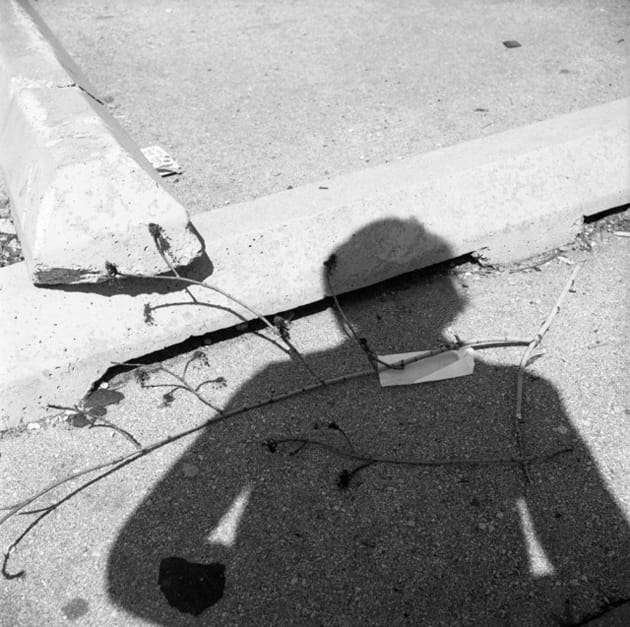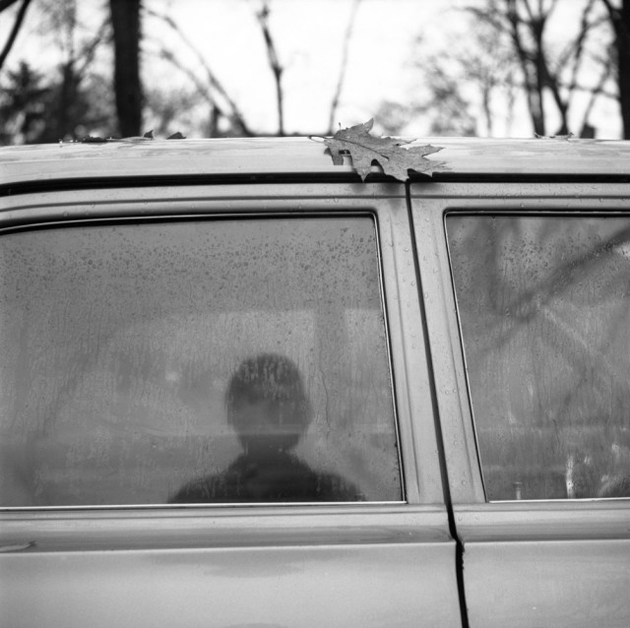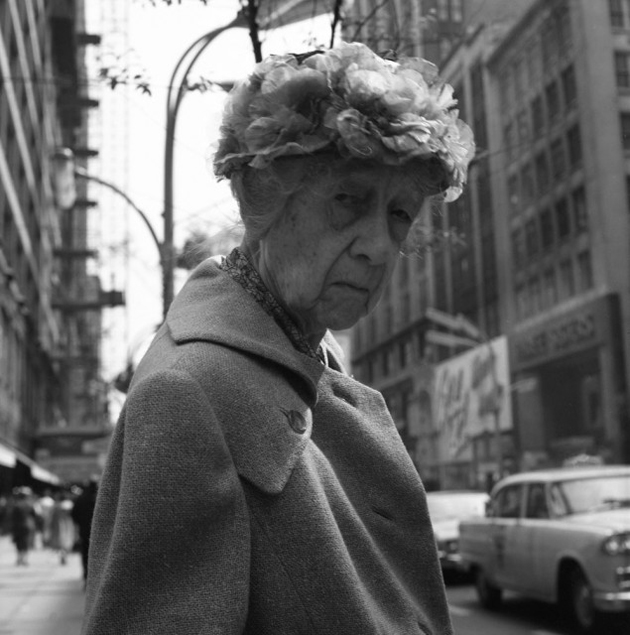Private Eye
Her neighbors remember her as “the bag lady,” but Vivian Maier was secretly a street photographer who would leave behind an artistic trove that captured the public’s imagination.

She was our neighborhood bag lady, but she looked more like a retired headmistress, or a librarian exiled from her bookish hideaway. Even rooting through trash bins at the beach or in the alleys, the haughty old woman always wore a long dress, a peaked hat, stockings, and blocky shoes, as though still dressing for a station in life she had long since fallen from.
Everywhere she walked, she carried a department store shopping bag, filling it with items discarded by people who could afford to be more careless with their possessions, items that, except for her intervention, would have fallen through the cracks of consumer society into oblivion.
Her gathering grounds were the upper right-hand corner of Chicago, a point where the city runs out of land, colliding with Lake Michigan and the North Shore suburbs. Rogers Park, as the neighborhood is known, is the attic of Chicago, where the city stores people it can’t use, but can’t get rid of, either. The main drag, Sheridan Road, is lined with adult care facilities whose residents sit outside on bus benches, smoking cigarette butts and cuddling headless dolls. Author Neal Pollack, who lived here in the late 1990s, called the locals “the sediment left over after you put the city of Chicago through a sifter.” There’s a hippie restaurant that has remained open for 38 years, even though everyone agrees that the food is terrible, the service is terrible, the kitchen is filthy, and the owner has no business sense whatsoever. There used to be a bar called The Ho, but it was condemned after the floor collapsed. When the Leather Archives and Museum outgrew its original location, in a more expensive neighborhood, the repository of S&M history found a new home in an abandoned Rogers Park synagogue. If you want to make a career out of being weird, this is the place. In Rogers Park, only the weird survive.
In Rogers Park, only the weird survive.
That’s why I was only mildly curious about the bag lady, even though I saw her at the beach nearly every day. The one time I tried speaking to her, she turned her long, sallow, sagging face toward me, fixed me with an evil eye, and returned her attention to the trash bin.
At the end of my block lives a burly, tattooed, bearded man I call the mayor of Eastlake Terrace. (Eastlake, a three-block long street that runs parallel to the lake, passing three narrow beaches, is where I live, and where Vivian did most of her scavenging.) Except for a tour of duty in Vietnam, Pat has lived here since he was four years old, in an apartment house built by his great-grandfather. Now, in his sixties, he owns the building, which provides him a leisurely retirement of sitting on a park bench with his dog and swimming in the lake on summer mornings. He knows everyone on Eastlake Terrace, and he knows their stories, too. So last fall, when it occurred to me that I hadn’t seen the bag lady for several years, I asked him, “Whatever happened to that woman who always wore the hat?”
Pat knew exactly who I was talking about.
“Oh, that was Vivian Maier!” he exclaimed, as though describing a mutual friend who’d left the neighborhood and made good. “It turns out she was an amazing photographer. After she died, someone discovered her pictures in a storage locker, and now they’re making a movie about her.”
“I didn’t know she was a photographer,” I said. “I never talked to her. The only person I ever saw her talking to was Dorothy,” a landlady of similar age and eccentricity who owned a crowded, aging building on the corner.
“I didn’t, either, and I guess I knew her as well as anyone,” Pat said. “Most people she wouldn’t give the time of day. She was always rooting through the garbage bins. I let her use my cane to pick up stuff. My sister gave her some of my mother’s old hats.”

Pat was the last person on our block to see Vivian alive.
“My sister looked out the window and said, ‘That lady you always talk to fell down.’ When the EMT came, she said, ‘Don’t let them take me.’ But of course they had to, to examine her. That was the last time I ever saw her.”
That was the end of her life in Rogers Park. According to a posthumous profile in Chicago magazine, her life ended in a suburban nursing home after she slipped on a patch of ice in downtown Chicago and struck her head. Vivian’s death the next year, in the spring of 2009, ended up making her famous. A few years before, local historian John Maloof had purchased more than 30,000 of Vivian’s negatives from an auction house, which acquired them after she failed to pay storage locker fees. Maloof quickly found a market for the photos—images of Chicago street life in the 1950s and 1960s, taken on days off from Vivian’s work as a suburban nanny—but was unable to discover anything about the photographer until he read her obituary in the Chicago Tribune. Since then, Vivian’s photographs have been the subject of a book, (Vivian Maier: Out of the Shadows), a BBC documentary, an exhibit at the Chicago History Museum, and now Maloof’s own documentary, Finding Vivian Maier, which premiered March 28 in New York City.
After Pat tipped me off that the bag lady was now recognized as a world-class photographer, I looked up Maloof’s Vivian Maier website, part of a multimedia empire he has built on the dead woman’s work. In her self-portraits, I recognized the same long, plain, expressionless face I’d seen in the park, though less lined, and less severe.
In her self-portraits, I recognized the same long, plain, expressionless face I’d seen in the park, though less lined, and less severe.
I also began my own Vivian Maier project, interrogating my neighbors for their memories of this woman who had left our block in ill health and penury, and was now returning to its consciousness as an international celebrity. In doing so, I discovered a distressing fact of modern big city life: how little we know about the people we see every day, and how, if Vivian had somehow become a renowned photographer in her lifetime, we would have known even less about her.
Barry gets his exercise by walking up and down the street in a University of Wisconsin sweatshirt. I’d seen him at least once a week for the last 10 years, but never spoken to him. Now I had an excuse.
“I know who you’re talking about,” said Barry when I described Vivian’s appearance and her accomplishments. “I haven’t seen her in years.” Although he was a member of the Chicago History Museum, where Maier’s work was on display, he hadn’t heard of it. He suggested I talk to Paul, who owned the building we were standing in front of.
Just then, Paul’s daughter-in-law, Anna Marie, emerged from the building, walking Paul’s dog. She knew about Vivian, because she’d watched a neighborhood screening of the BBC documentary in the apartment of a man who owned a building on the landward side of the street.
“Call Tom,” she said. “I think some of the old-timers in his building knew who she was.”
And just like that, thanks to Vivian Maier, I’d been introduced to three neighbors I’d never met.

My landlady remembered Vivian as “very strange. Tall and thin. Ethereal.” One night, I stopped Cathy, an Eastern European woman walking her pugs, and asked if she had known Vivian.
“She could be mean and ornery,” Cathy said. “One time, she almost got knocked down by a bike, and she turned around and bawled me out. But sometimes, I would come home and I would be wearing a shawl, and she would comment on the composition of the design. I felt sorry for her, because she was always collecting cigarette butts. She was a smoker.”
I called Tom. He’d hadn’t known Vivian—“I just saw her in the alley, going through Dumpsters”—but one of his ex-tenants had befriended the lonely, prickly woman. Tom gave me Eddie’s number.
Eddie had met Vivian on the rocks at Juneway Terrace Beach, where they both sat at sunrise.
“She was interesting-looking,” he remembered. “She had the hat. She looked like she could be out of the 1930s. I think I was sitting near her, I made a remark, and something happened. We just started talking, and every time we went there, we talked.”
Eddie worked in wood refinishing, but underneath that practical trade, he was an artist. When he told Vivian of his avocation, she insisted on visiting his apartment, to see his paintings. After that, she often rang his bell, asking to use his phone so she could apply for nannying jobs she’d read about in newspapers rescued from the garbage. (Vivian’s rent was paid by a man she’d cared for as a child, but Eddie saw her as impoverished, “in survival mode.”)
One Saturday, Eddie drove Vivian to a farmers’ market, and then to a yard sale. When he tried to introduce her to a seller, he realized he didn’t know her name. She never told him, either, although they engaged in long discussions of social issues, and, “like a nanny,” she often pestered him to dress better. Eddie knew nothing about Vivian’s past, or her photography, but he recognized a fellow creative spirit.

“I always felt there was something about her, she was talented in some area,” he said. “But she never had a camera. I thought she might be a writer. I thought she did something that was silent. Vivian, I think, chose to be alone. Vivian might have been arrogant to the point where she chose not to talk to people much, but she seemed to me to be missing something. It was her camera. If she was going to talk to anyone, it was someone like me, who fell through the cracks.”
Mike, the neighborhood handyman, does remember Vivian with a camera: “She was taking a picture of the ivy on a wall at sunset. It didn’t look like anything to me, but it must have to her.”
Eddie moved away from Eastlake Terrace in 2004, five years before Vivian died, and was unaware of her posthumous fame until he ran until his old landlord, Tom, at a Mexican restaurant.
“He brought up this photography, and I didn’t know who he was talking about,” Eddie recalled. “Someone you don’t think is anybody, and you know there’s something interesting about them, and then you find out—it’s sensational, out of this world.”
In 2010, I worked as a census enumerator on Eastlake Terrace, following up with people who hadn’t mailed back their forms. I discovered that a world-famous athlete lives among us. I can’t tell you his name, due to federal confidentiality regulations, but if you watched any of the last three Winter Olympics, you’d recognize it. One of Pat’s tenants, Eula Biss, won a National Book Critics Circle Award for Notes From No Man’s Land: American Essays, a book whose title essay is about life on Eastlake Terrace, but is less well known here than it is in the literary world. Pat has never read the book, even though he’s mentioned in it. We’re both neighbors and strangers, most of us. In some ways, Vivian was less of a stranger because she was so strange. All of us knew who she was, but none of us knew what she was. If she hadn’t been such an odd duck, we might never have known, either. The dissonance between her artistic brilliance and her obscure, destitute existence is the reason she’s the subject of two documentaries. Had Vivian published her photos in the ’50s and ’60s, when they were taken, she would have been forgotten by everyone but art students by the time she came to live among us—if she had come to live among us at all.
Over the winter, I visited the Chicago History Museum exhibit. Vivian was a great documentarian of her era, especially of marginal people who’ve been filtered out of the historical record, people whose pictures never appeared in Life magazine, or even the Chicago Tribune. People who “fell through the cracks,” as Eddie put it. People like her. But I’ll never be able to separate the woman from the work, because, in a small way, she relieved some of the urban alienation that cursed her final years by giving her old neighborhood something to talk about. Vivian never wanted to know most of the people around her, but because of Vivian, I know the people around me better than ever.
